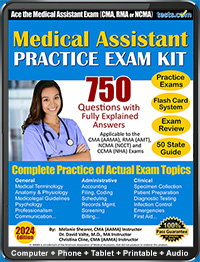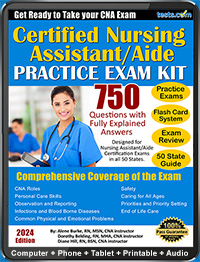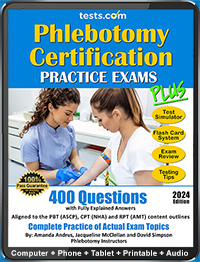Medical Assistant Test
Find Medical Assistant practice tests and practice exam questions, and other preparation resources, applicable to the Certified Medical Assistant (CMA), the Registered Medical Assistant (RMA) certification, the National Certified Medical Assistant (NCMA) and the Clinical Medical Assistant Certification (CCMA). For more information, see our Review of Medical Assistant Exams at the bottom of this page.
Review of Medical Assistant Exams - an excerpt from our full-length Medical Assistant Practice Exam with 300 questions with fully explained answers, review and testing tips.
There are a number of certifying bodies across the country. The three most prevalent are the medical assistant certifications offered by the American Association of Medical Assistants (AAMA), the American Medical Technologists (AMT) and the National Center for Competency Testing (NCCT). In most cases, certification by any of these organizations will be accepted nationally. Check with your employer to see what certification they prefer. There is no state licensure requirement for medical assistants unless a medical assistant seeks to work in a specialty area, like in radiography. Each of these organizations and their certification tests will be discussed below.
CMA (AMMA) Practice and Preparation
1. General Exam Information
The certification exam through the AAMA is offered to students who have graduated with a certificate of proficiency or higher in medical assisting from an educational institution that is accredited by either the Commission on Accreditation of Allied Health Education Programs (CAAHEP) or the Accrediting Bureau of Health Education Schools (ABHES). Students who have attended schools that are not accredited by either of these organizations are not eligible to sit for the certification exam through the AAMA. Those students who do not meet the above criteria and still apply for the exam will have their applications cancelled and charged an administrative fee
Upon completion of a properly accredited medical assisting program, students have five years to take the exam. However, in order to be considered a, “recent graduate,” and pay a lower certification fee, recent graduates must take the exam within 12 months of program completion. Graduates who wait more than one year after program completion will have to join the AAMA (fee varies by state of residence) and then pay a testing fee, or pay a non-member fee which is typically more costly. Those wishing to take the exam are encouraged to verify the most up-to-date exam fees at the AAMA website.
Applications that are verified and accepted by the AAMA will be approved for testing. Applicants will receive an email stating that they are registered to take the exam and have 90 days in which to do so. Applicants must then print out a scheduling permit that is taken to the testing center on the day of the exam. A government issued form of identification that includes both a signature and a photo of the applicant must also be presented to the testing site the day of the exam.
Applying for the CMA (AMMA) Exam
Applying for the CMA (AAMA) exam is a straight-forward process and is explained in detail in the CMA (AAMA) applicant handbook which is available to download from the AAMA website. For candidates that have completed an appropriately accredited program and have received program completion verification from the educational institution’s program director, choosing a 90 day testing period is the next step. The exam handbook lists the application deadlines for testing periods throughout the year. Applicants are encouraged to closely review the deadlines as they are binding; failure to submit an application before a stated deadline will result in a delay of the chosen testing period.
The last page of the candidate handbook is the actual application for the CMA (AAMA) exam and should be printed. All of the necessary requested information must be submitted or the application will be denied. Applicants are encouraged to have their applications reviewed by their program managers at their medical assisting schools to ensure accuracy of the information provided.
Approximately 30 days after the application has been mailed by the applicant, an email will be sent to the applicant from the AAMA providing notification of the registration status of the applicant. If all of the information has been received, the applicant will be listed as, “Registered,” for the exam. Any additional information that is needed will result in the applicant’s status listed as, “Incomplete,” and will require the applicant to take action on the missing documents or payment of fees for the exam.
For applicants that are listed as, “Registered,” a scheduling permit will be available for printing. This permit must be taken with the applicant to the testing center on the date that has been confirmed by the testing center. To obtain date confirmation, contact the nearest Prometric testing center. The web address for Prometric can be found in the candidate handbook. The last step in the application process is to review the candidate handbook for the test center policies and prepare according to those instructions.
2. Testing Expectations
Prometric testing venues offer state of the art examination administration. Centers are proctored and follow strict policies on candidate admittance and exam administration. Examinations are given in a controlled environment and many candidates are surprised at the level of care that is taken to protect the examination content. Prometric holds the CMA (AAMA) examination in high regard, therefore requiring all candidates follow specific instructions when entering the testing center. These instructions include storing all cell phones and electronic devices in lockers. No personal belongings can be taken into the testing room, so candidates are advised to leave any extraneous items at home. Jackets and sweaters are also not permitted, so prepare for potential colder conditions by dressing appropriately. Candidates are encouraged to review the Prometric policies before scheduling an examination. Any questions about procedures or policies of the testing centers should be directed to a Prometric official.
3. Exam Format
The CMA (AAMA) certification exam is a computerized multiple choice exam. The exam consists of 200 questions, of which only 180 are actually scored. However, the 20 questions that are not scored are questions that are being considered for future exams. The CMA (AAMA) candidate will not know which of the 200 questions are the 20 pre-test questions, so all 200 multiple choice questions must be taken seriously and answered to a candidate’s best ability.
The computerized multiple choice exam is a timed exam. All 200 questions must be answered in 160 minutes. An option for a total of 20 minutes of break time will be offered between testing segments. The testing segments are divided into four 40 minute increments. Candidates may choose whether or not to take a break, but total break time will not exceed 20 minutes, and total testing time will not exceed 195 minutes. An optional 15 minute tutorial is offered at the beginning of the exam and is recommended for all candidates as it explains in detail how to navigate through the exam.
4. Exam Content
The exam is broken down into three main content areas: General, Clinical, and Administrative. Each content area is then broken down into specific topic sections. General content contains topic sections such as Medical Terminology, Anatomy and Physiology, Professionalism, and Communication. Clinical content focuses on areas that are used in the day-to-day patient care aspects of medical assisting. Infection Control, Patient Preparation, Specimen Collection, and First Aid are covered in the Clinical content area of the CMA (AAMA) exam. Finally, office procedures are tested through the Administrative content area. Questions that focus on Filing, Billing and Coding, Accounting, and Office Policies can be found in the Administrative content area.
Candidates may be surprised at the scope and depth of the material covered by the exam. While some questions may focus on broad topics such as patient care and privacy concerns, other questions may be specific in nature. For example, it isn’t uncommon to find questions that ask for specific details of a procedure or calculation. Some questions may ask for conversion factors between the Metric System to the English measuring system or a candidate may encounter a question asking about the processor speed of a computer’s central processing unit. It is also strongly advised that candidates also prepare for questions concerning office management practices. Employee recruitment, payroll processes, interviewing methods, and resume review are also potential topics that may be used as material in the question pool.
An official examination content outline can be found on the AAMA website and is a valuable resource in preparing for the exam. Candidates are encouraged to print out the outline and review it even before studying for the exam. Many educators advise students to print out the outline when beginning their medical assisting education so that students can organize their notes according to the outline as classes are being taken. The outline can then be highlighted for areas that need the most attention when studying for the exam.
The Medical Assistant Practice Exam - ORDER NOW
RMA (AMT) Practice and Preparation
1. General Information
The AMT has a program that certifies medical assistants and offers the Registered Medical Assistant (RMA) credential. The AMT is a nationally and internationally recognized certifying agency. It is accredited by the National Commission for Certifying Agencies (NCCA). To take the exam and become certified through the AMT, the candidate must meet certain educational qualification standards. The candidate must be a recent graduate of a medical assisting program that meets certain accreditation requirements, have been employed in the profession of medical assisting for a minimum of five years or have passed a generalist medical assisting certification exam accepted by the AMT and been working in the profession for three out of the last five years.
To obtain the RMA (AMT), the candidate must take the RMA exam. After a candidate makes application to the AMT, the AMT Registrar will send the candidate an Authorization to Test letter. The letter will contain the necessary details to schedule the examination.
2. Test Information
The RMA (AMT) exam is given in either paper/pencil or computer based formats. Which format is offered to a candidate depends on the candidate’s situation and application route. If the candidate takes a paper/pencil exam, results are mailed in writing within six to eight weeks of the exam date. If the test is taken on a computer, results are given immediately at the test center. To ensure the integrity of the test, candidates are not permitted to bring the following into the testing center: papers, books, notes, unauthorized scratch paper, food, cellular phones, beepers, pagers, cameras, photographic or video equipment.
The computer based exam is administered by Pearson Vue at sites across the country. Once the candidate receives the Authorization to Test Letter from the AMT Registrar, the candidate is to contact Pearson Vue to schedule the test. If the test is given in writing, the test is given at AMT locations.
3. Exam Format
Candidates are given three (3) hours to complete the RMA (AMT) exam. There are 200 to
210 questions on the exam. The questions are multiple choice where the candidate is to select the single best choice from among alternatives. Questions may ask the candidate to recall facts, analyze data, use charts or graphs and solve problems. To pass the exam, the candidate must obtain a scaled score of at least 70. The scale used to score the test is from 0 to 100. The score given is not the percentage of questions answered correctly or the number of questions answered correctly.
4. Exam Content
The subject matter tested by the RMA (AMT) Exam is broken down into three general areas:
General Medical Assisting Knowledge, Administrative Medical Assisting and Clinical Medical Assisting. The General Medical Assisting Knowledge includes such subjects as Anatomy and Physiology, Medical Terminology, Law and Ethics. The Administrative Medical Assisting section covers such subjects as Insurance, Finance and Bookkeeping and Medical Secretarial and Clerical. Finally, the Clinical Medical Assisting section covers Instruments, Sterlization, Vital Signs and Measurments, Physical Examinations, Minor Surgery, Pharmacology, Laboratory Procedures and First Aid.
The Medical Assistant Practice Exam - ORDER NOW
NCMA (NCCT) Practice and Preparation
1. General Information
The NCCT offers the credential National Certified Medical Assistant (NCMA). It is accredited by the NCCA. To qualify to take the exam and receive the NCMA credential, a candidate must graduate from high school or have the equivalent degree of education and graduate from an approved medical assisting program of study or work in the field for at least two years. The NCMA credential is awarded for a five year period, at which time it must be renewed.
To receive the NCMA credential, the candidate must take an exam. Applications for testing must be received at least two weeks prior to the requested test date. Only candidates who currently attend NCCT approved programs can apply online. All other candidates must complete and deliver a paper application to the NCCT. NCCT Exam Coordinators schedule the tests to be given at sites that they designate. Candidates in NCCT approved educational programs may be able to take the exam at their school locations upon confirmation of eligibility.
2. Test Information
The NCCM exam consists of 150 questions and the candidate is given three (3) hours to complete the exam. The exam is multiple choice and each question gives four answer options, only one of which is the correct answer. The exam may be taken in either paper/pencil or computer based formats. Candidates select which format they want in the application. The passing score is determined by a subject matter expert panel. The passing point of the exam is designed to identify candidates with acceptable entry-level knowledge. Computer based results are available immediately upon completion of the test. The results of paper exams are sent to the candidate within four to six weeks of the test date.
3. Test Content
The NCCM exam covers knowledge, skills and abilities used in both the front and back office.
The exam covers such subjects as medical office management duties, general bookkeeping, insurance, medical procedures, infection control, patient exams, phlebotomy, EKGs, pharmacology, anatomy, physiology and medical terminology.






